#Patient Rehabilitation
Text
Electric Tilt Table
Electric Tilt Table Angular movement=vertical-0-deg-90-deg-tolerance-plusmn-5-deg-lt-hr-gt-back-flexion-0-deg-20-deg-lt-hr-gt-toe-flexion-0-deg-30-deg-tolerance-plusmn-2-deg; Control=handle-jog-controller; Recliner size=bed-board-1780-times-620-mm-lt-hr-gt-bed-height-550-mm; Loading capacity=100-kgs; Power rating=120-va;Shop Online at Medzer.com

#physical therapy tilt tables#rehabilitation table#tilt table therapy#adjustable tilt positions#patient rehabilitation#medzer
0 notes
Text
Navigating the Landscape of Medical Rehabilitation Services
The global medical rehabilitation services market size is expected to reach USD 385.9 billion by 2030. Medical rehabilitation services are intended to reduce disability and optimize functioning in individuals with specific health conditions.

Gain deeper insights on the market and receive your free copy with TOC now @: Medical Rehabilitation Services Market Report
The growth of the market is attributed to the rising geriatric population, the increasing prevalence of chronic conditions among adults, and the increasing number of children with developmental conditions. These factors are anticipated to increase the demand for the services due to the need for rehabilitation to prevent, treat, and manage these conditions. Rehabilitation services help to either minimize or slow down the disabling effects of chronic conditions in patients. For instance, according to the WHO as of July 2022, 1.71 billion people suffer from musculoskeletal conditions globally. These injuries are a leading cause of disability globally that limit the mobility and agility of patients leading to early retirement.
Medical rehabilitation helps to reduce hospital stays, thereby reducing healthcare expenditure, which is anticipated to boost market growth. Further, the increasing adoption of telerehabilitation services is projected to further drive the market due to the increased affordability and reduced costs. Increasing initiatives are undertaken by the government to increase the adoption of these services to fuel the growth of the market. For instance, Community Based Inclusive Development (CBID) program launched by the Indian Government in May 2021 aimed at providing training to rehabilitation workers with ground knowledge for managing cross-disability issues in disabled individuals working with ASHA and Anganwadi workers.
The increasing number of initiatives undertaken by the key players in the market in order to provide innovative solutions to the user is estimated to further drive the market during the forecast period. For instance, in October 2021, MindMaze Healthcare announced a partnership with Royal Buckinghamshire Hospital (RBH) for its MindPod platform targeted to treat motor and cognitive restoration in stroke patients. MindPod is an animated gaming environment developed by Johns Hopkins University School of Medicine's Department of Neurology that helps to repair the nervous systems after a stroke.
#Rehabilitation Services#Physical Therapy#Occupational Therapy#Recovery Care#Patient Rehabilitation#Medical Rehab#Rehabilitation Technology#Healthcare Recovery#Rehabilitation Medicine#Rehabilitation Programs#Injury Rehabilitation#Rehabilitation Clinics#Rehabilitation Equipment#Neurorehabilitation#Rehabilitation Specialists#Rehabilitation Outcomes#Holistic Rehabilitation#Rehabilitation Research
0 notes
Text

idk why, but this little throwaway line from beviin makes me crazy. it's so effortlessly compassionate in the face of boba's self-loathing and resigned certainty that beviin will hate him for what he's done. and like, beviin's gentle reassurance that he isn't going to "find out" anything; he'll just wait for if/when boba wants to share what happened.
beviin's genuinely such a mensch. i want to give him a hug.
#goran beviin#boba fett#legacy of the force#fett feels#i love how beviin has spent most of his life adopting and rehabilitating traumatized orphan kids#so every time boba comes at him with his own psychological damage beviin just effortlessly parries that shit without even blinking#GET UNCONDITIONALLY LOVED AND ACCEPTED IDIOT#GET ABSOLUTELY CHERISHED#i also just love beviin looking at this guy who's viewed by much of the galaxy—and also by himself—as an unfeeling‚ inhuman monster#and being like ''is anyone going to treat that with patient kindness and gentleness? no? guess it's gotta be me then''
44 notes
·
View notes
Note
Hi Nell0 how are you? I could be better because the first time in my life I broke a bone and it had to be my foot. I was just doing my laundry and all of a sudden I fell. A doctor visit later yep it’s broken and it going to be 6 weeks until it’s good again. Sorry about the rant and also the other day I saw a Ingo is Kyruem fan art and my gosh I ended up remembering that AU you had! If it had continued I would be fighting the reality barrier to be there for him while also trying to get Emmet to come too! Well then I gotta go now but thx for reading! Also quick question. What LOZ game you tried to like but you couldn’t? For me personally I haven’t had that happen… yet! 🧚♀️
Hi again, anon!
Make sure to rest properly and then rehabilitate the foot for good propioception for it so you don't get more issues there shortly after! Keep in mind you'll lose some muscle mass in the area too, but that can be won back easily with simple exercises once the immobilization is over. Depending on the bone, maybe leaving it on a cast or such more than 3-4 weeks isn't the best though, there could be stiffness as a result and loss of range of movement (aka ROM).
Don't quote me on that, but uh, yeah. That. And there's also the part of doing a progression and not rushing the recovery once immobilization is over, you'll probably have to start with partial weight and not be able to walk normally right away (I explain myself so badly, sorry. As you probably know by now, English ain't my first language). I hope you recover nicely and don't have any issues!
But ANYWAYS.
The Kyurem Ingo stuff was so great to mess around with! I think I saw a drawing for another version of it not that long ago. Lowkey made me wanna continue my own, but TLOZ + LU still have me on a chokehold.
I haven't tried a TLOZ game that I haven't liked thus far, tho tbh I've been avoiding Zelda I & II for now. Haven't heard great things about the playability of Zelda II, lol.
#asks#excuse my little infodump#I'm used to explaining this stuff at work#and it just takes over my life#bc I love talking about rehabilitation#good thing for my patients I guess#talk tag#had to hold back from writing an essay about feet rehab#didn't think it would be this hard omfg#the amount of stuff I had to delete to keep it short lol
7 notes
·
View notes
Note
i just saw a post about andrew and his meds and how he was probably misdiagnosed for depression but he’s actually bipolar which made him manic all the time bc of his meds and!!!! yes to me andrew has always been bipolar. anyways i just had to share this with someone what are you thoughts on bipolar andrew? i know this isn’t kevin related and for that i’m sorry
"i know this isn’t kevin related and for that i’m sorry" HRGJLDHFGDFJG KDFJG FUNNY....!!!! i do answer non-kevin related asks sometimes but the flesh and the spirit must be willing... i'd say it's occasional like an expert briefly commenting on another expert's field
i thought bipolar andrew was canon? isn't it? i've never really had any extensive thoughts about it; to me it was just a fact of the world like the foxes are orange and kevin is beautiful..... well. regardless. i think it's a good hc if that's what it is :) i'm not all that interested in diagnosing aftg characters with personality disorders and i think a diagnosis of something is not always a concrete reality of life and more so a guideline to follow to deal with a specific cluster of symptoms, but as far as they go, andrew being bipolar makes a lot of sense!
i have a friend who went through the foster system when they were younger and a few years ago i do remember we were talking about andrew and they said a lot of how he was written was taken textbook from a 'how to foster troubled children' manual, which i think is most of what i think about re: andrew's mental health. to me it is more interesting (fiction wise!) to think about the material conditions that caused him to develop the symptoms he did, and less so about the ultimate conclusion of them. does this make sense?
tl;dr: i thought andrew being bipolar was already canon, if it's a hc then it's cool :=)
#asks#andrew#ive never really been much interested about personality disorders or really psychology as a broader term#not because i've never needed therapy or meds (pah! can you imagine!)#but because i think just as a base line that the human experience is very plural and complicated#and the state of modern psychiatry / psychology eludes a lot of that complexity#to ultimately serve the purpose of rehabilitating patients not as human beings but as 'functioning' workers and potential consumers#please note that i am not saying i am anti psychology&psychiatry#i'm just recognizing it as an apparatus of capitalism like every industry is#and especially caregiving industries#sorry this is such a tangent. i need to read up more theory on this after all#but yes. andrew!
8 notes
·
View notes
Text
this is a random late night thought, i know, but i'm just thinking about how the orderlies in arkham must react to finding barton cuddling with his bunkie in the morning if they had a nightmare orrr they both needed to get warm (like i believe i've mentioned previously on here before). like, idk what gave me this impression, but for those of them that just don't give a shit about their job rather than the abusive a-holes (i honestly feel like these are the two main categories of orderlies that work at arkham, NGL)...
i really do feel like they'd do something like place bets between themselves as to whether they think something is going on between certain inmates or not. and when they're either proven right or wrong, they exchange the money they bet on it. because these people unfortunately could not care less about the fact that in barton's case (and possibly in other's cases), he literally does it as a means of survival / to have a source of comfort most of the time because that place is god awful
#OF MONSTERS AND MEN: musings.#ooc post.#tw: mentions of the mistreatment of patients.#tw: mentions of medical malpractice.#yeahhh. i honestly could talk about how they likely dehumanize all of the patients in arkham in more quote unquote 'subtle' ways like this#as well as more obvious ways for a while because that place is just brimming with corruption TBH and some of the treatments that they-#do as well as the equipment that they use are just... YIKES. that's the only word i could use for it because they're just so severely-#outdated and also tend to be cruel towards the patients as well unfortunately#but i just think that the place kind of encourages their staff to adopt either a 'i don't give a crap about anything' sort of attitude-#or a 'these people are awful and so i'm going to do whatever i like here' type of attitudes as well which are definitely not the best to-#have because you desperately need to practice empathy in a place that is supposed to be used for rehabilitation but let's be honest...#the doctor's there are also part of the problem
3 notes
·
View notes
Text

Grandpamare has decided to change for the better.
Undertale by Toby Fox
Nightmare by Joku
Abyss by MetaKazkz
Grandpamare AU by me
#cittys art#undertale#sans#abyss#abyss!sans#nm#nightmare#nightmare!sans#grandpamare#he is rehabilitating people!!#his patients are Killer and Dust at the moment#Abyss is the receptionist who will help him run the whole rehabilitation center
6 notes
·
View notes
Text
UnitedHealthcare, the largest health insurance company in the US, is allegedly using a deeply flawed AI algorithm to override doctors' judgments and wrongfully deny critical health coverage to elderly patients. This has resulted in patients being kicked out of rehabilitation programs and care facilities far too early, forcing them to drain their life savings to obtain needed care that should be covered under their government-funded Medicare Advantage Plan.
It's not just flawed, it's flawed in UnitedHealthcare's favor.
That's not a flaw... that's fraud.
44K notes
·
View notes
Text
Finding Light in the Darkness by Rashik Hasrat Rivu
The Path of Healing at Golden Life On-site Wellness Services.
TAKE ROOT, GIVE HOPE.
Things I know about God, What Is Generosity?
When we are living in this world of shadows & land of monsters, where the choices that we make often take down infamous roads to hell, the path to recovery may seem vast and endless. We, at Golden Life Mirpur Drug Addiction Treatment Center in Bangladesh, understand that addiction is not just an individual fight; it is a social battle calling out to families and societies.
The Weight of Choices
Picture waking up every day burdened by the pressure of what society wishes you to be, not who you truly are. This causes them great anxiety which is what pushes people into drugs, a vacuum from pain, and a world weary stress. Yet all too often, those choices lead them further into darkness, leaving them more alone and more hidden than ever.
We recognize many pathways to addiction — be it because of trauma, loneliness, or just a quest for belonging. A vicious cycle of binge-watching leads to a chasm of desolation and deprivation that forbids your sincere belief whereno light appears in the end.
A Place of Understanding
In addition to treatment, we provide compassion. We are the sanctuary where all calls get answered. We offer a platform for your stories, for young adults dealing with depression and struggling…for those people experiencing their weakest moments…and also for discovering their strengths… It is in these shared experiences that healing starts on the right foot.
The Strength Found in Bonds
A powerful statement is made in the report on the healing processes. This is vital as when individuals open up their fears and share their successes, they realize that their life struggles are not one-sided. Every individual can expose sentiments in group therapy sessions no holds barred, where the rawness of emotions spills out, and closeness is established. Such attachments grow to become umbilical cords to each individual reminding that even at the darkest moments, there still exists a tiny burn that is waiting to be kindled.
How does one restore their self-control?
Recovery cannot be said to be in straight lines but rather in curves with ups and downs. It is the same situation at Golden Life but instead, we live with this ambiguity, acknowledging that restoration takes time and inner strength. Each professional, be it a psychologist, a counselor, or a medical provider, walks with the person and carries out what they know best depending on the stage of that person on their healing journey.
We do not focus on detoxification only; we also eliminate the problems associated with drug abuse – the cause. We assist patients in going back to where the trouble began and help them learn how to find themselves. With every bit of progress, the patients start to take back who they once were.
A Plea to Families
To all the people who are living with a recovering addict; the power of your love is great. Get involved. Speak to your loved ones, and let them know what they can do and how they can help.
Healing is not just about the individual; it’s about rebuilding connections and fostering understanding within families. Together, you can create a nurturing environment that encourages recovery, it is also about repairing relationships and restoring harmony in families. It is also possible to make a society where the healing process is possible.
Adopting Optimism
While it may appear otherwise, at Golden Life we are not treating ailments; we are fostering hope. Everyone has it in them to get up and do all the things that they once loved and be happy again and no longer under the influence of drugs.
If you or a loved one are up against the wall of addiction today, please know that there is still hope and that there is a place of peace waiting for you. Contact us today. Let’s take this step together so we can move out of this sadness and live the beautiful life that is waiting for us.
In this transformation, you are not merely a victim, but a fighter. And in Golden Life, we are privileged to be part of your journey reclaiming your life’s story and starting a new one with limitless opportunities.
A Covenant of Healing: Our Pledge at Golden Life In the quiet corners of our hearts, we all share a fundamental truth:
Every soul longs for connection, understanding, and the opportunity to overcome challenges. At Golden Life, the Mirpur Drug Addiction Treatment Center, we wholeheartedly embrace this truth, dedicating ourselves to serving, healing, and uplifting every individual who enters our doors. Our Vision: A Tapestry of Resilience We dream of a world where compassion and empathy intertwine to create a vibrant tapestry of resilience. A world where every person, regardless of their past, is greeted with kindness, and where the stigma surrounding addiction is replaced by acceptance and love. We believe that healing is not a solitary journey; it’s a collective effort, a shared adventure of rediscovery and redemption. Our Mission: To Ignite the Flame Within Our mission goes beyond traditional treatment methods. We aim to spark the inner flame within each individual, awakening the hidden strength that lies beneath layers of pain and struggle. We work to create an environment where vulnerability is embraced, and every story shines as a beacon of hope. In the depths of darkness, we will light the way toward healing.
Our Commitment: To Serve with Integrity and Compassion In our pursuit of this noble mission, we make a profound commitment: 1. Dignity and Respect: We promise to treat every individual with the utmost dignity and respect. We recognize that addiction can diminish one’s sense of self, and we are dedicated to helping restore that sense of worth, reminding each person that they are deserving of love and a second chance. 2. Holistic Approach: We are committed to addressing the mind, body, and spirit. Our comprehensive treatment programs aim to heal not just the symptoms of addiction, but also the underlying issues that contribute to it. We believe that true recovery involves emotional, psychological, and physical well-being. 3. Empathy as Our Guide: We pledge to walk alongside each person with empathy as our guiding principle. We listen intently to their stories, creating space for their pain while nurturing their hopes. Our hearts are open, ready to embrace the complexity of their journeys. 4. Family as Allies: We understand that families play a crucial role in the healing process. We commit to involving loved ones, providing them with the education and support necessary to understand addiction and promote recovery. Together, we can mend relationships strained by addiction and build a supportive network of care. 5. Continuous Growth: We promise to stay dedicated to learning and evolving. As the landscape of addiction and recovery shifts, so will our approaches. We will remain informed, adaptable, and responsive to the needs of those we serve, ensuring that our methods uphold the highest standards of care.
Our Oath: A Pact of Healing and Hope With each breath, we renew our commitment to protect and serve those who seek refuge in our care. We vow to be a reliable source of hope, a guiding light in times of darkness. In this sacred space, we will create an environment of trust and healing, where every individual is empowered to reclaim their life and purpose. A Call to Humanity We invite you, as part of this shared human experience, to join us in our mission. Whether you are seeking healing, a family member, or an ally in the battle against addiction, your role is essential. Together, we can break down the barriers of stigma and build bridges of understanding. Let us remember that within every challenge lies the growth potential. In the struggle, there is strength. In the journey through pain, there is the promise of renewal. Together, we can transform despair into hope and suffering into resilience. At Golden Life, we are dedicated to the belief that every soul deserves healing. Together, let’s create a future where love overcomes stigma, where every life is cherished, and where the path to recovery is met with unwavering support. In unity, we move forward, transforming lives and nurturing the essence of humanity. Together, we rise. Together, we heal.
We do not imagine a world where any person is left in the misery of despair, but a world where every man, woman, and child has a chance regardless of the actions they have taken in the past, or the mistakes they have made, can build his life from scratch.
#mental patient#rehab center#health#mental health#drugs treatment#cnc drugging#addiction#drugs rehab#best rehabilitation centre in Dhaka
0 notes
Text
Understanding Orthopedic Care: Why It Matters

Orthopedics is a medical specialty focused on diagnosing, treating, and preventing conditions affecting the muscles, bones, and joints. This includes bones, joints, ligaments, tendons, and muscles. Whether it's a fracture, joint pain, or a more complex condition like arthritis or osteoporosis, orthopedic care plays a crucial role in restoring mobility and improving the quality of life.
Common Orthopedic Conditions
Fractures and Dislocations: Accidents can lead to bone fractures or joint dislocations, requiring immediate medical attention. Orthopedic surgeons are trained to treat these injuries effectively, ensuring proper healing and rehabilitation.
Arthritis: A condition that causes inflammation of the joints, arthritis can significantly impact daily activities. Orthopedic specialists provide both surgical and non-surgical treatments to manage arthritis symptoms and improve joint function.
Sports Injuries: Athletes often suffer from injuries like torn ligaments, sprains, and fractures. Orthopedic care is essential for quick recovery and preventing long-term damage.
Spinal Disorders: Conditions like herniated discs or spinal stenosis can cause severe pain and limit mobility. Orthopedic experts offer treatments that range from physical therapy to minimally invasive surgeries.
Why Choosing the Right Orthopedic Hospital Matters
Selecting the right orthopedic hospital is crucial for ensuring effective treatment and a smooth recovery. The Best Orthopedic Hospital in Bargarh offers comprehensive services that address a wide range of orthopedic needs, from minor injuries to complex conditions. With advanced diagnostic tools, skilled surgeons, and personalized rehabilitation programs, patients receive exceptional care tailored to their specific needs.
By opting for the best orthopedic facility in Bargarh, patients can trust that they will receive the highest standard of care, provided by experienced professionals dedicated to restoring mobility and alleviating pain.
#Orthopedic Care#Best Orthopedic Hospital#Bargarh Healthcare#Bone and Joint Health#Orthopedic Treatment#Advanced Orthopedics#Joint Pain Relief#Fracture Treatment#Spinal Care#Arthritis Management#Rehabilitation Services#Orthopedic Surgeons#Patient Care#Orthopedic Recovery.
0 notes
Text

Explore advanced rehabilitation services for trauma patients at Healix Hospitals. Our expert care helps ensure a comprehensive recovery journey.
Do Visit: https://www.healixhospitals.com/blogs/advanced-rehabilitation-services-for-trauma-patients-at-healix-hospitals
#Advanced Rehabilitation Services#Trauma patient recovery#Physical therapy#Post-trauma rehabilitation#Rehabilitation programs#Recovery services#Rehab facilities#Trauma care rehabilitation#Healing and recovery#Occupational therapy#Rehabilitation specialists#Post-injury care#Comprehensive rehab services#Rehabilitation treatments#Patient rehabilitation plans#Trauma recovery support
1 note
·
View note
Text
#paralysis treatment#Paralysis exercises for recovery patients#Physiotherapy Exercises for Paralysis Patients#exercise for paralysis patient#paralysis recovery exercises#paralysis treatment in Kolkata#medical rehabilitation center#physiotherapy in kolkata#physiotherapy clinic
0 notes
Text
Ranchi's 'Nirmal Awas' Offers New Hope for Leprosy Patients
CM Soren inaugurates modern housing complex for affected individuals
Jharkhand government initiative provides dignified living spaces and essential amenities to marginalized community.
RANCHI – A transformative housing project in Ranchi marks a significant step towards social inclusion and improved quality of life.
Chief Minister Hemant Soren has unveiled a groundbreaking residential complex for…
#राज्य#CM Hemant Soren initiatives#Jharkhand government welfare schemes#Jharkhand social welfare#leprosy patient housing#leprosy rehabilitation programs#Nirmal Awas Ranchi#PMAY Jharkhand#Ranchi infrastructure development#social inclusion housing#state#urban development projects
0 notes
Text
Physiotherapy Treatment For Paralysis in Navi Mumbai
doctor of Sanjeevni Physiothery Clinic is expert in physiotherapy treatment For Paralysis in Navi Mumbai. Our experienced team helps you regain mobility, strength & independence. Contact us for a consultation!
https://sanjeevaniphysiotherapyclinic.com/physiotherapy-treatment-for-paralysis-navi-mumbai/

#list of physiotherapists for paralysis in navi-mumbai#doctors for paralysis in navi mumbai#physiotherapy for paralysis#physiotherapy for right hand paralysis#physiotherapy for paralysis patient#physiotherapy for leg paralysis#physiotherapy for left sided paralysis#physiotherapy treatment for paralysis patient#physiotherapy for right side paralysis#neurological rehabilitation#paralysis management#functional recovery#motor relearning#spinal cord injury rehabilitation#stroke rehabilitation#neuroplasticity#gait training#strengthening exercises#range of motion exercises#balance and coordination training#mobility enhancement#assistive device training#electrotherapy for paralysis#functional electrical stimulation#adaptive equipment#therapeutic exercises#neurodevelopmental techniques#functional mobility#rehabilitation protocols#patient-centered care
0 notes
Text
Prehab vs. Rehab: Which Approach Should be Prioritized in the ICU?

For the past five years, I have been engrossed in exploring the history and current culture of the ICU, as they relate to the ABCDEF Bundle.
As a result, I’ve been faced with having to compare my ingrained understanding of early mobility to the cultural “norms” I see at the bedside, as well as in the literature.
One of the key differences between these two perspectives, which I’ve been confronted with, is the timing and focus (or lack thereof) on early mobility in the ICU.
This contrast is captured in the comparison between prehab vs. rehab, and the debate about which approach should be prioritized in the ICU.
Prehab vs. Rehab: What’s the Difference?
If you want to understand the difference between prehab vs. rehab and learn which approach should be prioritized in the ICU, you’ve got to know what each one entails.
That being said, let’s explore the difference between prehabilitation and rehabilitation.
What Is Rehabilitation?
The Oxford Dictionary defines rehabilitation as “the action of restoring someone to health or normal life through training and therapy after illness.”
In the context of the ICU, the literature usually states that “Early rehabilitation is essential to reducing complications associated with PICS. ‘Early’ refers to rehabilitation interventions that commence immediately after stabilization of physiologic derangements, often while patients remain on mechanical ventilation and vasopressor infusions.”
And after years of attending conferences, visiting with dozens of ICU teams across the U.S., and reviewing their data and protocols, it is clear to me that rehabilitation in the ICU is perceived as the inevitable need for intensive physical recovery after mandatory and standard prolonged bed rest in the ICU.
But what we see in studies published within the last 6-8 years is that the “intensive rehabilitation” intervention groups did not even have patients sitting at the side of the bed until 8 or 9 days after intubation.
Even the recent TEAM study did not sit patients up at the side of the bed until 4-6 days after intubation following prolonged sedation at a median RASS of -3.
Yet the TEAM study is being hailed as the model of “ICU rehabilitation” and is considered an earlier and more aggressive level of rehabilitation than what you’ll find in most ICUs in the U.S.
What I’ve witnessed is that although many hospital protocols will allow for mobility to occur during critical illness, and while patients are on vasopressors, etc., it is not actually occurring in practice.
The approach shared by most of the ICU community is that mobility will happen when ventilator settings are minimal, when the patient follows commands, after extubation, after the tracheostomy, after vasopressors are discontinued, etc.
It seems as long as physical or occupational therapy consultation orders are entered before the patient transfers from the ICU, early mobility is checked off of the list as done.
But when you consider that on average, critically ill patients lose nearly 2% of skeletal muscle per day during their first week in the ICU, it’s clear that delaying mobility can lead to devastating consequences.
These consequences, including the loss of physical and cognitive function, result in a desperate need for ICU rehabilitation.
As a result, ICU rehab tends to be implemented as the recovery from delirium and ICU-acquired weakness on the back end of critical illness.
But what if we focused more on preventing delirium and ICU-acquired weakness?
What Is Prehabilitation?

Prehabilitation is defined as a process of improving the functional capability of a patient before a procedure or treatment so they’re able to withstand any inactivity and associated decline.
That being said, most patients do not anticipate sudden critical illness, so how does prehabilitation apply in the ICU?
In 2002, Robert Topp defined prehabilitation in the ICU as “The process of enhancing functional capacity of the individual to enable them to withstand the stressor of inactivity associated with an admission to ICU.”
A prehabilitative approach in the ICU respects the fact that patients arrive at the ICU with risk factors for delirium and ICU-acquired weakness and may have a long and complicated hospital stay ahead of them.
At this point, their physical, cognitive, and psychological function are already in peril and require proactive intervention focused on the preservation of functional capacities.
This leads ICU teams to promptly implement interventions to prevent delirium and ICU-acquired weakness, such as nutrition, early mobility, sleep hygiene, and family engagement.
For most patients, prioritizing prevention rather than recovery can drastically change the outcomes they experience.
For instance, the timing of early mobility impacts short and long-term outcomes for patients in the ICU.
A recent study showed that when early mobility happens within 72 hours of ICU admission there is a positive impact on post-ICU syndrome, but these benefits are limited if early mobility is initiated after 72 hours have passed.
Another study revealed that mobilizing patients within less than 72 hours after intubation led to a 24% improvement in return to functional baseline and a two-day decrease in delirium and time on the ventilator.
We also know that mobilizing patients within 48 hours after intubation improves cognitive function by 20% one year after discharge.
Prehabilitation in Practice

For the first eight years of my career, I was unfamiliar with the term ICU rehabilitation.
All I knew was that physical and occupational therapy are a standard part of care with the same priority as antibiotics, vasopressors, and AM labs. Walking my intubated patients on the night shift was just as optional as their bed bath.
The word rehabilitation usually only came up on the rare occasion when we were disappointed that we were sending a patient to a care facility instead of back home.
Our shared goal was to have patients walk out of the doors and avoid extensive rehab.
But when I started working in an Awake and Walking ICU, our patients were mobilized within 12 hours after intubation unless there was a contraindication to mobilization.
The decisions of whether or not to start sedation, what type of sedation to use, and whether or not to mobilize patients were esteemed as a “clinical priority on a par with early resuscitation, early sepsis management, and a lung-protective strategy.”
When the teams I train adapt this prehabilitative approach, they immediately notice the contrast in patient outcomes and workload.
What’s more, they enjoy being able to protect patients from the occurrence and severity of ICU delirium and ICU-acquired weakness, rather than having to rehabilitate patients after these complications have developed.
I trained Andrea Silva’s team in Denver, Colorado about a year ago, and they have transformed their process of care from a back-end rehabilitation approach to a front-end prehabilitation approach.
Here’s what she had to say about it:
“Prehabilitating patients in the ICU not only decreases length of stay, but it also reduces vent days and prevents delirium. There is a sense of nursing satisfaction and fulfillment when you see your patients thrive and walk out of the ICU.
“The morale around the unit has had a positive shift by seeing our patients succeed. We used to rehabilitate patients in the ICU by doing mobility after extubation, but our delirium rates were high, everyone had tracheostomies and PEG tubes, and they were waiting for placement in care facilities. Now patients are walking home from the ICU.”
So, what if prehabilitation becomes the norm?
What if it took 2-3 clinicians to walk an intubated patient down the hall rather than 3-5 people to sit a patient at the side of the bed?
What if we reduced delirium rates from where they are now, at 60-80%, and turned delirium into something that rarely occurs in the ICU?
What if we were able to enjoy calm, cooperative, and functional patients?
What if we shifted our focus to proactive instead of reactive?
And what if our efforts were dedicated to protection rather than recovery from delirium and ICU-acquired weakness?
If we were to do all of these things, I can only imagine how many lives would be saved and preserved, and the effect this could have on generations of ICU patients and clinicians to come.
If you and your team are ready to master the ABCDEF Bundle and create an Awake and Walking ICU, please don’t hesitate to sign up for a free consultation.
0 notes
Text
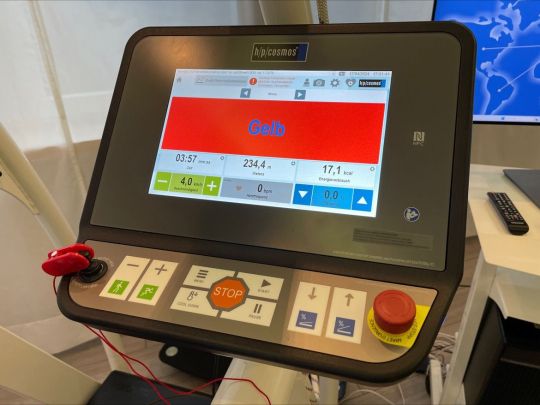
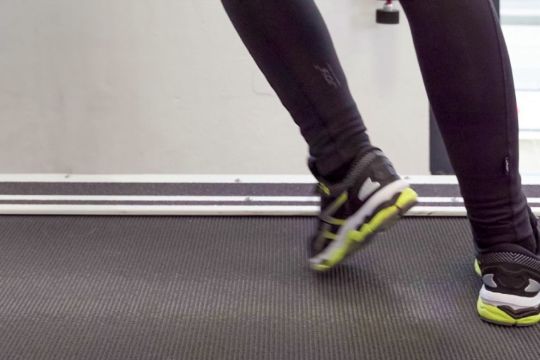
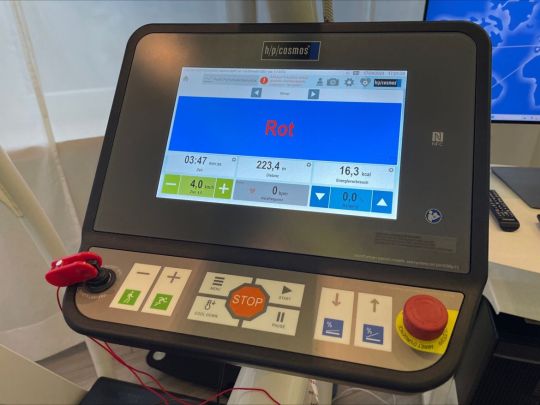


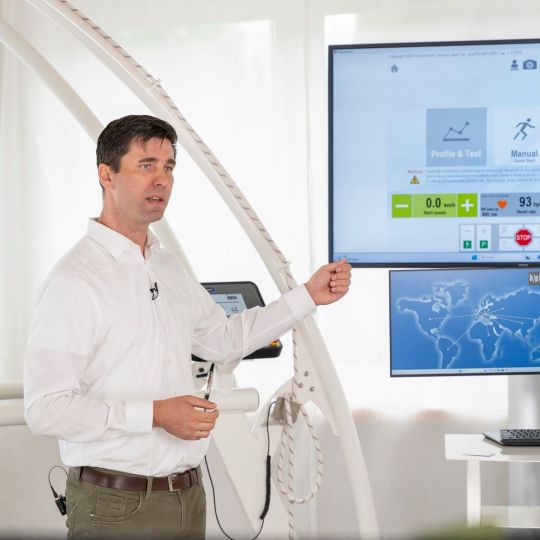

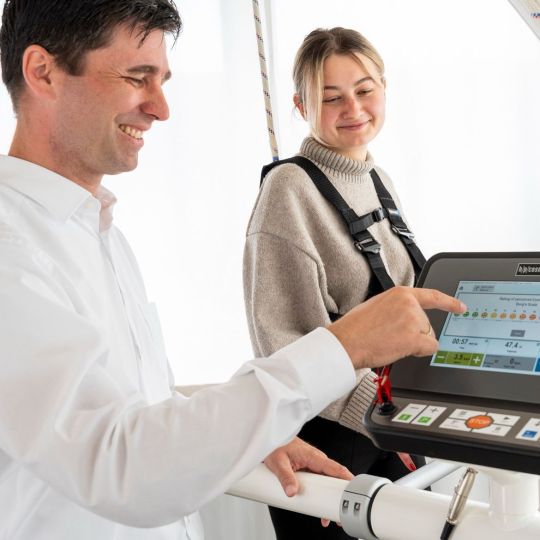
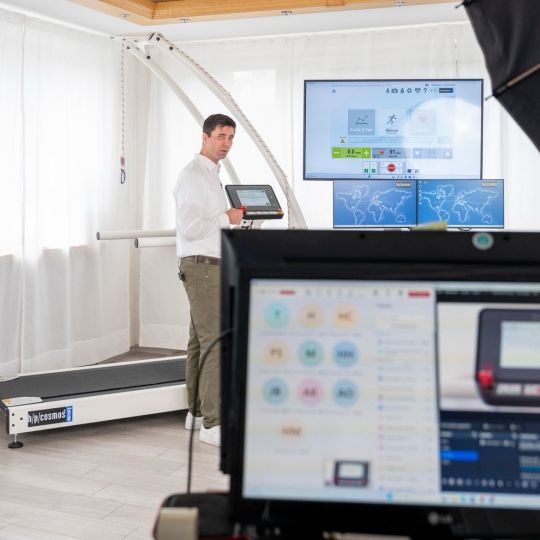
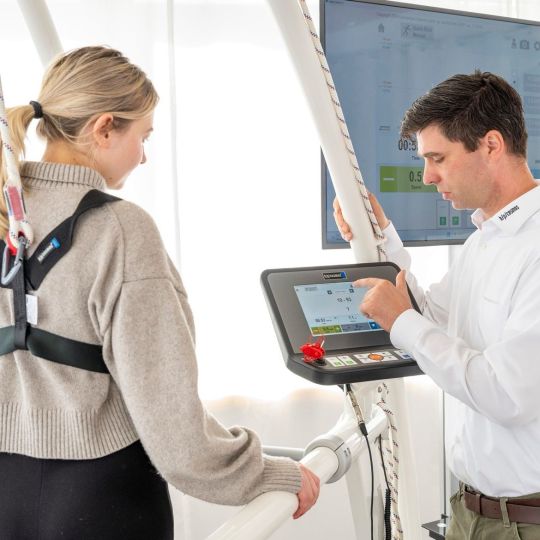
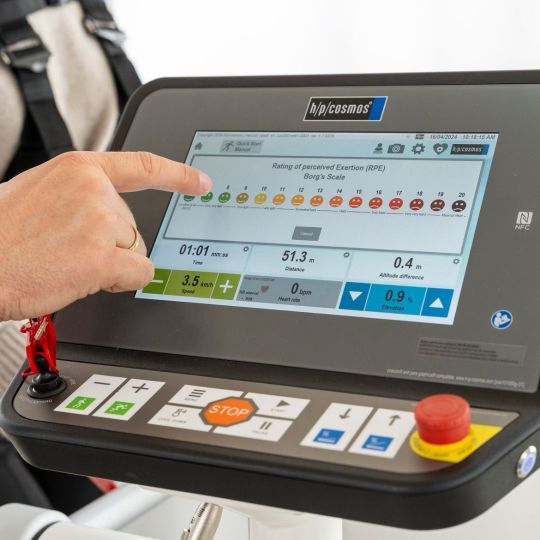

Free webinars: „The Perturbation Module for gait stability. Setup, Applications & FAQ for h/p/cosmos treadmills with MCU6”.
#neurorehabilitation #parkinson #FallPrevention #PerturbationTreadmill #GaitTraining #Balance #athletics #DualTasking #CognitiveSkills #Laufband #Stolperlaufband #Sturzptävention
These 2 free webinars h/p/cosmos will hold on May 7th 2024. Both webinars will be held live by our Application Specialist and Authorized Signatory Dr. Björn Zimmermann.
Following the successful webinar by Sabine Lamprecht, M.Sc. Neurorehablitation (HSH Lamprecht) for the German speaking therapists, we are now diving into the technical sphere of the latest UserTerminal generation MCU6 to provide both our partners as well as product owners, therapists and trainers with a detailed insight to the possibilities of our perturbation module.
Focus topics will be: general functionality of the perturbation module, utilization of the pre-set perturbation profiles, programming personalized perturbation profiles, combining the perturbation profiles with dual tasking.
We are very much looking forward to welcoming to either to the morning session (9.00 am CET) or to the afternoon session (5.00 pm CET).
The webinars will be held in English language.
https://www.hpcosmos.com/.../webinar-perturbation-module...
Registration 09:00 am CET:
Registration 05:00 pm CET:
The recording of Sabine Lamprecht, M.Sc. German speaking webinar is available here.
https://www.hpcosmos.com/en/news/webinar-innovative-treadmill-therapy-focus-perturbation
Video:
#treadmill#rehabilitation#neurorehabilitation#neuroplasticity#mcu6#Stolperlaufband#perturbationtreadmill#dualasking#stability#GaitTraining#parkinson patient#hpcosmos#parkinson's disease#laufband#gaitway
0 notes